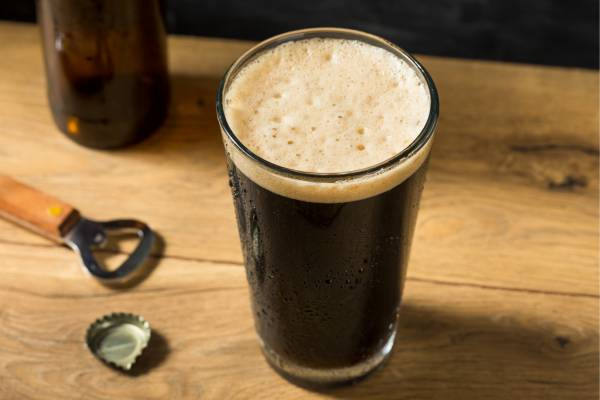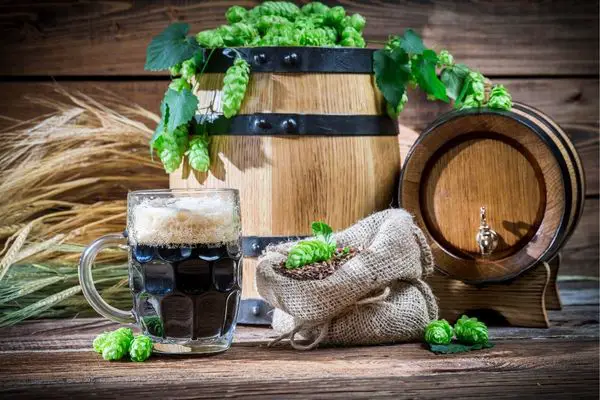As an expert brewer and a beer enthusiast, I have tasted my fair share of beers from all over the world.
One of the most iconic and recognizable beers out there is, without a doubt, Guinness. But is Guinness a stout, a lager, or an ale?
Here are some key facts about Guinness and its relationship to stouts, lagers, and ales:
1. Guinness is a type of stout, which is a subcategory of ales.
2. Stouts are characterized by their dark color, roasted malt flavor, and often a higher alcohol content than other ales.
3. The use of roasted barley and the distinct flavor profile of Guinness are what classify it as a stout.
4. The main difference between ales (including stouts) and lagers is the type of yeast used in fermentation.
5. Ales use top-fermenting yeast, while lagers use bottom-fermenting yeast.
6. Guinness has a rich history dating back to 1759.
7. The brewing process of Guinness involves mashing, lautering, boiling, fermentation, and maturation.
8. Guinness is known for its dark, almost black color, and its thick, creamy, and long-lasting white head.
9. The aroma of Guinness includes roasted malt, coffee, and chocolate notes, while its flavor is rich and complex, balancing sweet malt and bitter hops.
10. Lagers tend to be lighter in color and have a cleaner, crisper taste than ales.
In this blog post, I will take you on a journey through the different aspects of Guinness, discussing its history, brewing process, and what sets it apart from other beers. So, let’s dive right in and explore the wonderful world of Guinness!
A Brief History of Guinness
Guinness has a rich history dating back to 1759 when Arthur Guinness signed a 9,000-year lease on the St. James’s Gate Brewery in Dublin, Ireland.

Over the years, Guinness has grown into a global brand and is now brewed in almost 50 countries worldwide. The distinct dark color and rich, creamy taste of Guinness have made it one of the most popular beers in the world.
The Brewing Process of Guinness
Guinness is made from four simple ingredients: water, barley, hops, and yeast. The barley is roasted, giving the beer its signature dark color and unique taste.
The brewing process of Guinness involves several steps, including mashing, lautering, boiling, fermentation, and maturation.
Mashing
The brewing process begins with mashing, where the roasted barley is mixed with hot water to create a mash. This process extracts the sugars from the barley, creating a sweet liquid called wort.
Lautering
Next, the wort is separated from the spent grain through a process called lautering. The wort is then transferred to a boiling kettle.
Boiling
During the boiling process, hops are added to the wort. Hops contribute to the beer’s bitterness and aroma. After boiling, the wort is cooled and transferred to a fermentation vessel.
Fermentation
Guinness uses a proprietary yeast strain, which is added to the cooled wort to begin fermentation. The yeast converts the sugars into alcohol and carbon dioxide, creating the base for the beer. The fermentation process typically takes about a week.
Maturation
Finally, the beer is allowed to mature for several weeks, allowing the flavors to develop and the beer to become carbonated.
Tasting Guinness: Appearance, Aroma, and Flavor
When enjoying a pint of Guinness, there are several aspects to appreciate.

Appearance
Guinness is known for its dark, almost black color, which is achieved through the use of roasted barley. When poured correctly, the beer forms a thick, creamy, and long-lasting white head.
Aroma
The aroma of Guinness is a combination of roasted malt, coffee, and chocolate notes, with a hint of earthy hops.
Flavor
The flavor of Guinness is rich and complex, with a balance of sweet, roasted malt and bitter hops. The mouthfeel is smooth and creamy, making it a truly enjoyable beer to savor.
What Makes Guinness a Stout?
As mentioned earlier, Guinness is a type of stout, which is a subcategory of ales. Stouts are characterized by their dark color, roasted malt flavor, and often a higher alcohol content than other ales.

The use of roasted barley and the distinct flavor profile of Guinness are what classify it as a stout.
How Does Guinness Differ from Lagers?
Lagers are a different category of beer altogether. The main difference between ales (including stouts) and lagers is the type of yeast used in fermentation. Ales use top-fermenting yeast, while lagers use bottom-fermenting yeast. Lagers tend to be lighter in color and have a cleaner, crisper taste than ales.
Conclusion: Guinness is a Stout, a Subcategory of Ales
To wrap up, let’s revisit the main question: is Guinness a stout, a lager, or an ale? The answer is thatGuinness is a type of stout, which is a subcategory of ales.
I hope this blog post has given you a deeper understanding of and appreciation for Guinness and its unique place in the world of beer. Remember, whether you’re enjoying a stout like Guinness or a crisp lager, the most important thing is to savor the experience and share it with friends. Cheers!
FAQs
What class of beer is Guinness?
Guinness is a class of beer known as Stout, specifically an Irish Dry Stout. It is characterized by its dark color, rich and creamy texture, and roasted malt flavor with a hint of coffee and chocolate notes.
What’s the difference between Guiness and a lager?
Guinness and lager are two different types of beer with distinct characteristics. Guinness is a type of stout, which is a dark, heavy beer with a rich, roasted malt flavor. It originates from Ireland and is known for its creamy, smooth texture and iconic dark color, often with a thick, foamy head.
On the other hand, lager is a lighter, golden-colored beer with a crisp, clean taste, originating from Germany.
It is brewed using bottom-fermenting yeast at colder temperatures, resulting in a less fruity, more subtle flavor profile compared to ales, like Guinness. The main differences between Guinness and lager lie in their color, flavor, brewing process, and origin.
How is Guinness different from lager?
Guinness is different from lager primarily in terms of ingredients, brewing process, and taste.
Guinness is a type of stout, which is a dark, heavy beer made from roasted malt or barley, hops, yeast, and water. In contrast, lager is a lighter, crisper beer made from malted barley, hops, yeast, and water.
The brewing process for Guinness involves a longer fermentation period at a lower temperature compared to lagers, which results in a richer, creamier texture and a distinctive roasted flavor profile. Lagers typically have a cleaner, more refreshing taste with a lighter body and higher carbonation levels.
What makes Guinness so different?
Guinness is different from other beers due to its unique combination of ingredients, brewing process, and serving technique. The key factors that make Guinness distinct are:
1. Ingredients: Guinness uses roasted, unmalted barley, which imparts a rich, dark color and a distinct roasted flavor to the beer. The use of nitrogen gas instead of carbon dioxide also contributes to its creamy texture.
2. Brewing process: Guinness undergoes a two-stage fermentation process, which allows the beer to develop its complex flavors and smooth texture. Additionally, the beer is brewed with a proprietary strain of yeast, which imparts its unique taste.
3. Serving technique: Guinness is served using a two-step pour, which involves pouring the beer at a 45-degree angle and allowing it to settle before topping it off. This process creates the beer’s iconic thick, creamy head and cascading effect.
Overall, the combination of these factors results in a beer with a smooth, creamy mouthfeel, a distinct roasted flavor, and a rich, dark appearance that sets Guinness apart from other beers.
Is Guinness a lager beer?
No, Guinness is not a lager beer. It is a type of stout, specifically an Irish dry stout, known for its dark color, creamy head, and distinctive roasted barley flavor. Lager beers are typically lighter in color and have a crisper taste, resulting from a different brewing process and the use of bottom-fermenting yeast.




